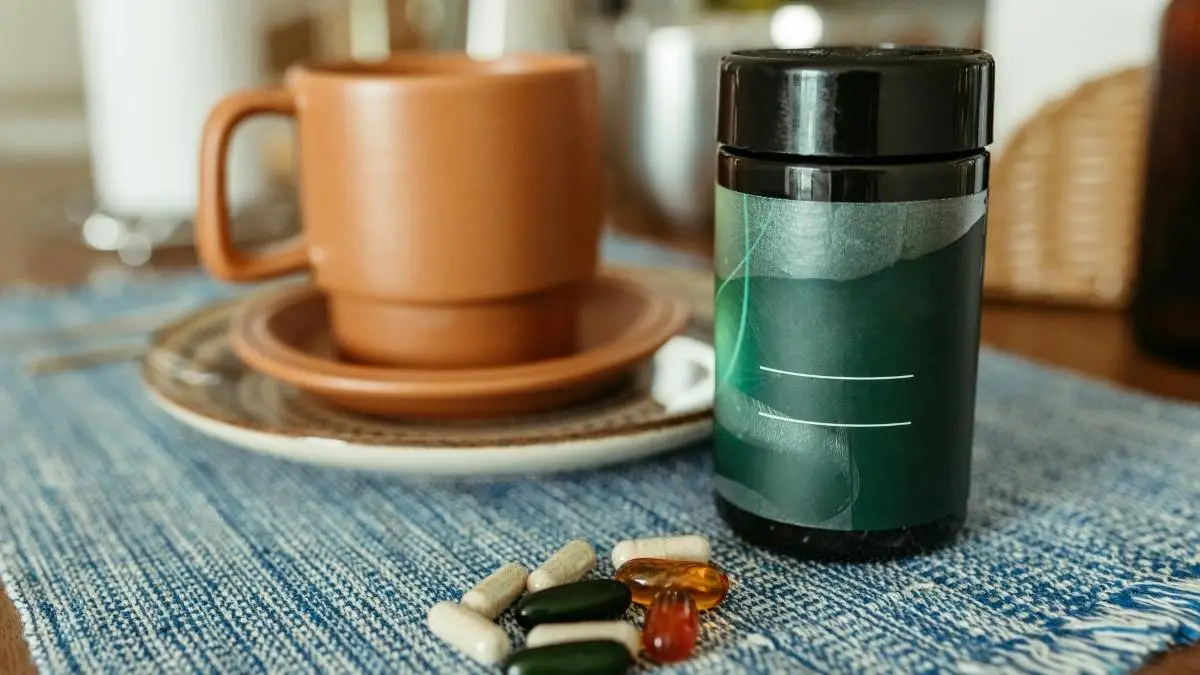That cabinet full of supplements is likely doing more for the industry’s profits than for your health. Americans spend over $50 billion a year on these pills and powders, chasing the promise of better health in a bottle.
But here is the industry’s best-kept secret: most of what you take doesn’t work. It’s not just a few bad products; the entire system is designed to sell you hope, not results. From useless ingredients your body can’t absorb to a complete lack of rules, you’re buying into a multi-billion dollar illusion.
This report will show you exactly how it works and give you a simple guide to stop wasting your money and start making choices based on facts.
The Big Health Lie: Why More Vitamins Don’t Make You Healthier

The main idea behind the supplement industry is simple: if a vitamin is good for you, then more of it must be better. But science shows this isn’t true.
If you are a healthy person who eats a decent diet, taking extra nutrients in a pill usually doesn’t help prevent sickness. Sometimes, it can even be harmful. The belief that supplements boost your health ignores how your body actually uses nutrients from real food.
Why Real Food Is Better Than Pills
Vitamins and minerals don’t work alone. In food, they come inside a “food matrix.” This is a mix of fiber, plant chemicals, and other things that help your body absorb and use the nutrients.
For example, fruits and vegetables are full of helpful plant chemicals called phytochemicals. Most pills don’t have these. Research shows that a nutrient from food works differently than the same nutrient taken alone in a pill.
Major scientific studies back this up. One huge review published in a top medical journal found there is not enough proof that most vitamin supplements help prevent heart disease or cancer.
Experts agree that taking isolated nutrients doesn’t give you extra protection. One medical journal put it bluntly: “the case is closed—supplementing the diet of well-nourished adults with (most) mineral or vitamin supplements has no clear benefit and might even be harmful… Enough is enough.”
You can’t use supplements to fix a bad diet. A dietician explained that supplements are just concentrated bits of food.
They can’t copy the benefits of eating well. He said, “Vitamin D is related to the immune system, but taking more vitamin D won’t make us more immune to COVID. We can only have an immune system within our human nature—we won’t be superheroes.”
Which Popular Supplements Don’t Work?
When you look at specific supplements, the proof they don’t work for most people is even clearer.
Multivitamins:
These are one of the most popular supplements, but studies show they don’t lower the risk of major diseases or help healthy adults live longer. They are meant to add to your diet, not replace healthy food.
Antioxidants (Vitamin E & Beta-Carotene):
These were once seen as a cure-all. Now, research is very disappointing. A major health task force now recommends against using vitamin E or beta-carotene to prevent heart disease or cancer.
Many studies show vitamin E gives no benefit. Even worse, beta-carotene has been shown to increase the risk of lung cancer in people who smoke.
Weight Loss Supplements:
This area is full of false promises. A review of 315 different studies found that people taking weight-loss pills didn’t lose much more weight than people taking a sugar pill. These supplements are also often secretly filled with illegal drugs.
“Miracle” Cures:
It is illegal for a supplement to claim it can treat, cure, or prevent any disease. Any product that says it can is breaking the law.
This includes supplements sold for serious problems like cancer or HIV. These claims are fake and can be very dangerous if they cause people to stop using real medical treatments.
When “Natural” Is Actually Dangerous
People think supplements are safe because they are “natural.” This is a dangerous mistake. When you take nutrients out of food and pack them into a pill, they can cause real harm. They can be toxic or mess with your prescription medicines.
The risk of getting too much is high with vitamins A, D, E, and K. Your body stores these in fat, and they can build up to toxic levels. For example, too much vitamin A can hurt your liver. Too much vitamin D can cause kidney stones.
Even vitamins that your body pees out can be a problem in very high doses. Too much B6 can cause nerve damage, and a lot of vitamin C can cause stomach problems.
Supplements can also cause serious problems with prescription drugs.
- St. John’s Wort: This herb can make many drugs less effective, including birth control pills and antidepressants.
- Vitamin K: This vitamin helps your blood clot, so it can work against blood-thinning medicine.
- Vitamins C & E: Some proof suggests high doses of these antioxidants might make some cancer treatments less effective.
- Ginkgo Biloba: This can increase the risk of bleeding if you take blood thinners.
These are not small risks. Supplements send about 23,000 people to the emergency room in the U.S. each year. Many are young adults with heart problems from weight-loss or energy products.
This huge gap between what people believe and what science says is driven by marketing. You want easy health solutions, so you buy supplements.
The industry spends nearly $1 billion a year on ads with vague promises like “more energy.” This cycle wastes your money and creates a public health risk.
The Regulation Problem: A ‘Wild West’ Market

The reason so many supplements are useless or dangerous is not an accident. It’s because of a law passed in 1994 called the Dietary Supplement Health and Education Act (DSHEA).
This law created a “Wild West” market where companies can sell thousands of products with almost no government checks for safety or quality.
The Law That Left You Unprotected
Under DSHEA, supplements are treated like a special kind of food, not like drugs. This is the main source of the problem.
Drugs have to go through years of testing to prove they are safe and that they work before they can be sold. The Food and Drug Administration (FDA) has to approve them first. Supplements do not have this rule.
The FDA does not have the power to approve supplements for safety or effectiveness before they are sold.
The company that makes the supplement is responsible for its safety. But they don’t have to show their proof to the FDA. The FDA can only act after a product is on the market and has been proven to be dangerous.
This puts you, the consumer, in the position of being a test subject. And getting a bad product off the shelves takes a very long time. It took the FDA seven years to ban the stimulant ephedra after it was linked to deaths.
What “Not FDA Approved” Really Means
You have probably seen this on a supplement bottle: “These statements have not been evaluated by the Food and Drug Administration.
This product is not intended to diagnose, treat, cure, or prevent any disease.” This is a required legal warning. It means the company is making a health claim without any proof that the product actually works.
Because it’s so easy to get a product on the market, there are now 50,000 to 80,000 different supplements for sale. The FDA doesn’t even know about all of them. This has led to huge problems with quality.
- Contamination: Products are often found to be dirty with things like lead or other germs.
- Hidden Drugs: This is a big danger with supplements for weight loss, sexual performance, and bodybuilding. They are often secretly spiked with powerful drugs like steroids or the active ingredient in Viagra. You could be taking strong medicine without knowing it.
- Wrong Labels: What’s on the label is often not what’s in the bottle. One investigation found that 80% of top-selling store-brand herbal supplements didn’t contain any of the herbs listed on their labels. Instead, they had cheap fillers like powdered rice and houseplants.
Why the FDA Can’t Keep Up
The FDA is supposed to police this market, but it doesn’t have enough people or money to do the job. The agency’s main tool is sending a Warning Letter to a company after finding a problem. But these letters are often sent months after an inspection.
Even the rules that do exist have holes. Companies are supposed to follow Good Manufacturing Practices (cGMPs), but these rules don’t cover whether the ingredients are safe or effective. Companies get to set their own standards for quality.
This means a 500 mg turmeric pill from one company can be totally different from another, but both can be legal. This is the key difference between real medicine and the supplement industry.
Here is a simple breakdown of the differences:
Prescription Drugs
- Pre-Market Approval: Required by FDA for safety & efficacy.
- Proof of Efficacy: Must be proven through clinical trials.
- Proof of Safety: Must be proven before marketing.
- Manufacturing Standards: Strict, federally mandated rules.
- Health Claims: Can claim to “treat, cure, or prevent” disease.
- FDA Oversight: Proactive (checks before selling).
Dietary Supplements
- Pre-Market Approval: Not required.
- Proof of Efficacy: Not required.
- Proof of Safety: Not required to be shown to FDA before marketing.
- Manufacturing Standards: Rules required, but standards can be self-defined.
- Health Claims: Legally prohibited from making these claims.
- FDA Oversight: Reactive (checks after a problem happens).
The Absorption Barrier: Why What’s on the Label Doesn’t Reach Your Cells

Even if a supplement is clean and has the right label, there’s one more big problem: your body probably can’t use it. This is called the bioavailability barrier.
It’s a scientific reason why a “pure” product can still be useless. The trip from a pill into your body’s cells is tough, and many supplements fail because of cheap ingredients and bad design.
Bioavailability: The Trip from Pill to Cell
Bioavailability measures how much of a substance actually gets into your bloodstream to have an effect. A shot given in a vein has 100% bioavailability.
But a pill you swallow has to survive your stomach acid, get absorbed in your intestines, and pass through your liver. At every step, some of the ingredient is lost.
How much your body absorbs depends on many things. It depends on the chemical form of the nutrient, the pill or capsule it’s in, and even what you ate with it. Your age, genes, and gut health also play a big part.
Not All Forms of a Nutrient Are the Same
The chemical form of a vitamin or mineral is very important. Companies can use cheap forms that your body can’t absorb well, or more expensive forms that work much better. This is a key way they cut costs.
- Magnesium: Many cheap supplements use magnesium oxide. Your body doesn’t absorb this well. In fact, it’s used in laxatives because most of it just passes right through you. Better forms, like magnesium citrate or glycinate, are much easier for your body to use.
- Vitamin B12: The cheapest form is cyanocobalamin. Your body has to convert it to use it. Better forms like methylcobalamin are already active and ready for your body to use.
- Iron: Iron can be hard to absorb. Some forms, like ferrous bisglycinate, are absorbed well even when you eat foods that normally block iron.
- Curcumin: This is the active part of turmeric. It’s very hard for your body to absorb on its own. Good curcumin supplements add something like black pepper extract to help your body absorb it.
The Problem with “Inactive” Ingredients
The “Other Ingredients” list on a label is important. These are fillers, binders, and coatings. Some are needed to make the pill, but others are cheap shortcuts that can block absorption.
Here are some red flags:
- Magnesium Stearate: This is used to keep machines running smoothly. Some proof suggests it can form a film around the active ingredients, which may slow down how well your body absorbs them.
- Artificial Colors and Flavors: These are totally unnecessary. They are often found in low-quality products like gummy vitamins to make them taste better.
- Titanium Dioxide: This is a pigment used to make pills look white. It has no health value.
- Magnesium Silicate (Talc): This is basically baby powder used as a filler. It has been linked to health problems.
Because the law doesn’t require companies to prove their products work or can be absorbed, there’s a strong reason for them to use the cheapest ingredients.
The business model is based on selling the idea of health, not actually delivering it. You are left with a product designed for profit, not for your well-being.
How to Read a Supplement Label and Spot the Tricks

To avoid wasting your money, you need to become a detective. You have to learn to read a supplement label for what it really tells you, not what it promises.
How to Read the “Supplement Facts” Panel
This panel is where you find the key information. Here’s how to read it:
- Serving Size: Look at this first. All the information on the label is based on this amount. A common trick is to list a small serving size, like “1 capsule,” when you might need to take three or four to get a real dose. This makes the product look cheaper or stronger than it is.
- Amount Per Serving: This tells you how much of each ingredient is in one serving. You should compare this amount to what scientific studies say is an effective dose.
- % Daily Value (%DV): This shows how much of the FDA’s recommended daily amount you get in one serving. But these values are for a typical healthy adult and might not apply to you. Many herbs won’t have a %DV.
- “Other Ingredients” List: This is below the main panel. It lists all the fillers and binders. The ingredients are listed by weight, from most to least. A long list of “other ingredients” is often a sign of a low-quality product.
Red Flag #1: The “Proprietary Blend” Game
One of the most deceptive tricks is the “proprietary blend.” This lets a company list a group of ingredients but only give the total weight of the blend. They don’t have to tell you how much of each ingredient is inside.
This allows for something called “fairy dusting.” A company can put a tiny, useless amount of an expensive ingredient in the blend just to put it on the label. The rest of the blend could be cheap filler like rice powder.
A proprietary blend makes it impossible to know if you’re getting a useful dose of anything important. Be very suspicious of products with these blends.
Red Flag #2: Vague Claims and Weasel Words
Supplements can’t legally claim to cure a disease. But they can make “structure/function” claims. These are fuzzy statements like “Supports a healthy immune system.”
Bad marketers use these claims with “weasel words” to hint at a benefit without breaking the law. Watch out for phrases like “promotes vitality” or “enhances rejuvenation.”
Also, be careful with fake science-sounding words like “thermogenesis.” These are meant to confuse you. Another red flag is using testimonials from fake doctors or happy customers who claim amazing results.
Here is a quick look at some common supplements and the real science:
- Multivitamin
- Marketing Claim: “Fills nutritional gaps,” “Health insurance in a bottle.”
- The Science: No clear proof it prevents disease in healthy people. A good diet is much better.
- Key Risks: Can be toxic if you also eat a lot of fortified foods.
- Vitamin C (high dose)
- Marketing Claim: “Boosts immunity,” “Prevents the common cold.”
- The Science: Does not prevent colds for most people. It might make a cold slightly shorter.
- Key Risks: High doses can cause stomach problems and kidney stones.
- Omega-3 Fish Oil
- Marketing Claim: “Supports heart and brain health.”
- The Science: Proof is mixed on whether it prevents a first heart attack. It can lower triglycerides.
- Key Risks: High doses can increase bleeding risk and interfere with blood thinners.
- Collagen
- Marketing Claim: “Improves skin, hair, and joints.”
- The Science: Some small studies show it might help, but there is not much strong, long-term proof.
- Key Risks: Usually safe, but quality can be a problem.
- Probiotics
- Marketing Claim: “Improves gut health.”
- The Science: Effects depend on the specific type (strain). Some strains help with certain issues, but broad “gut health” claims are often not proven.
- Key Risks: Quality is a big issue; the product may not have what the label says.
How to Use Supplements the Smart Way: A 2025 Guide

The point of this article is not to make you angry, but to make you a smarter consumer. The goal is to shift your thinking from just believing the ads to checking the facts. You can use supplements wisely, but you need to use proof, not marketing, as your guide.
Step 1: Food First. Test, Don’t Guess.
The most important rule of nutrition is to get your nutrients from whole foods. Supplements are meant to add to your diet, not replace it.
Before you think about taking a supplement, talk to a doctor or a registered dietitian. Trying to diagnose yourself with a nutrient shortage from a website is a bad idea. The only way to know for sure if you have a deficiency is with a blood test from a doctor.
Most people don’t need supplements, but some groups do. These include:
- Pregnant Women: Folic acid is very important to prevent birth defects.
- People with a Diagnosed Deficiency: If a doctor tells you that you are low in iron or B12, you need a supplement.
- Vegans: People who eat no animal products may need to take vitamin B12.
- People with Absorption Problems: Certain diseases make it hard to absorb nutrients from food.
- People with Bone Health Issues: Calcium and vitamin D are often recommended for osteoporosis.
- People with Age-Related Macular Degeneration (AMD): A special mix of vitamins has been shown to help slow this eye disease.
Step 2: Trust, but Check. The Value of Third-Party Testing.
Since the FDA doesn’t check supplements for quality before they are sold, the best way to know if a product is good is to look for a seal from a third-party testing group. These groups buy products and test them to make sure they are high quality.
The most respected third-party testers in the U.S. are:
- U.S. Pharmacopeia (USP): A USP seal means the product has what the label says, doesn’t have harmful contaminants, and will break down properly in your body.
- NSF International: An NSF seal means the product has what the label says, has no hidden ingredients, and was made in a clean facility. They also have a “Certified for Sport” seal for athletes.
- ConsumerLab.com: This group does its own tests and publishes the results. A product that passes may show a CL seal.
It is very important to know what these seals do not mean. A third-party seal is about quality control. It checks for purity and a correct label. It does not mean the product works or will make you healthier. You have to check the scientific proof for that separately.
Here is a summary of what the seals mean:
- U.S. Pharmacopeia (USP)
- What It Guarantees: Has the right ingredients at the right strength. No harmful junk. Breaks down in your body.
- What It Does NOT Guarantee: That the product actually works or has health benefits.
- NSF International
- What It Guarantees: Has the right ingredients. No hidden junk. Made in a good facility.
- What It Does NOT Guarantee: That the product actually works or has health benefits.
- NSF Certified for Sport
- What It Guarantees: Everything NSF guarantees, plus it’s tested for over 280 things banned in sports.
- What It Does NOT Guarantee: That it will improve athletic performance or has health benefits.
- ConsumerLab.com (CL)
- What It Guarantees: The product passed their tests for quality and purity.
- What It Does NOT Guarantee: That the product actually works or has health benefits.
The 2025 Smart Supplement Checklist
Here is a simple checklist to use when you think about taking a supplement.
- Talk to a Pro: Before taking anything, talk to your doctor or a registered dietitian. Tell them about your health goals and any medicines you take.
- Get Tested, Don’t Guess: If you think you are low on a nutrient, get a blood test to be sure.
- Eat Real Food First: Make healthy, whole foods the main part of your health plan. A pill can never replace a good diet.
- Check the Proof: Look for real scientific proof that a supplement works for your specific goal. Use good sources like the National Institutes of Health (NIH) website.
- Look for the Seal: If you need a supplement, pick one with a third-party seal from a group like USP or NSF.
- Read the Whole Label: Be a detective. Check the serving size, look for good forms of nutrients, and say no to products with “proprietary blends” or a lot of junk fillers.
- Report Problems: If you have a bad reaction to a supplement, stop taking it, get medical help, and report it to the FDA. This helps protect other people.


